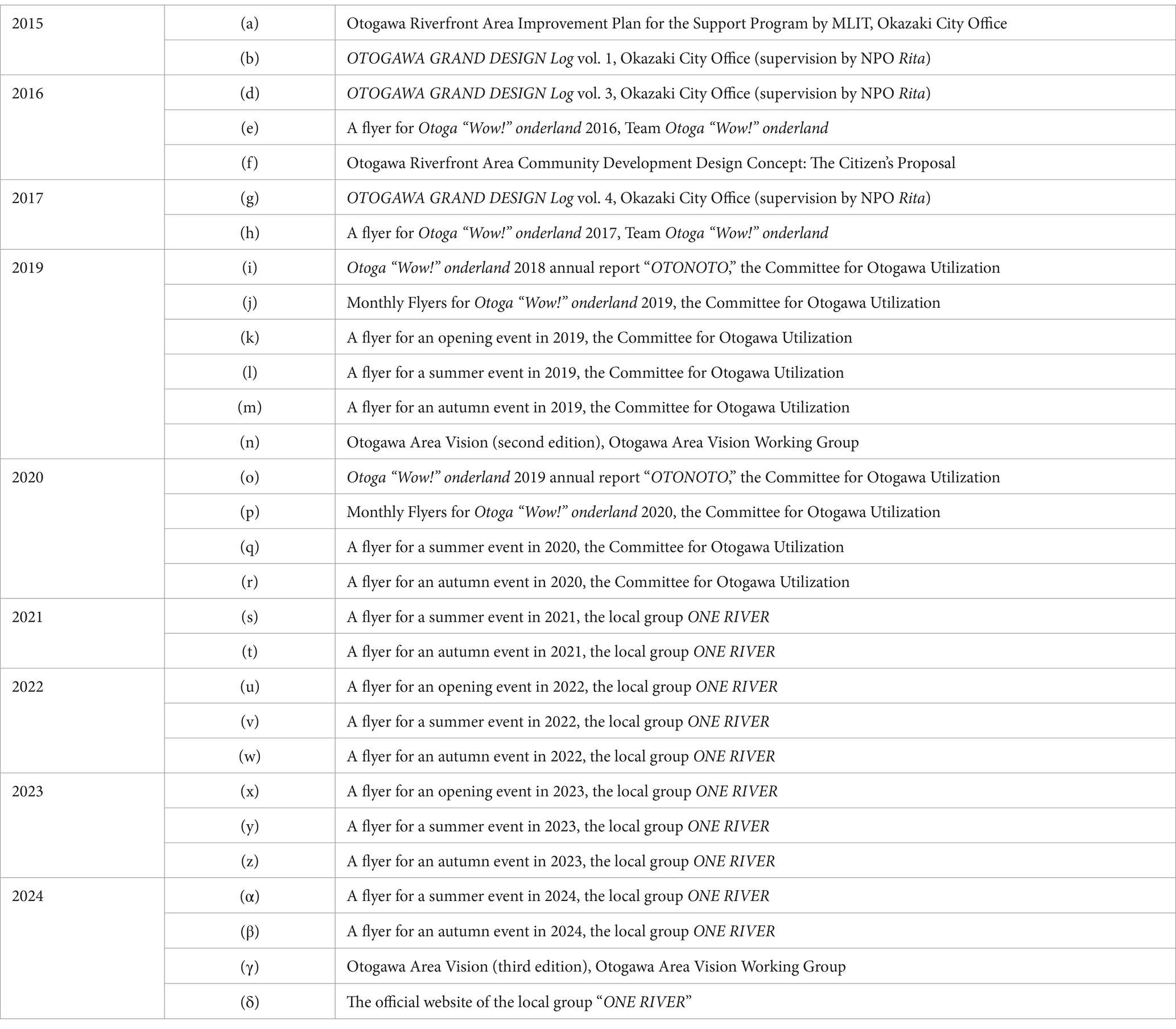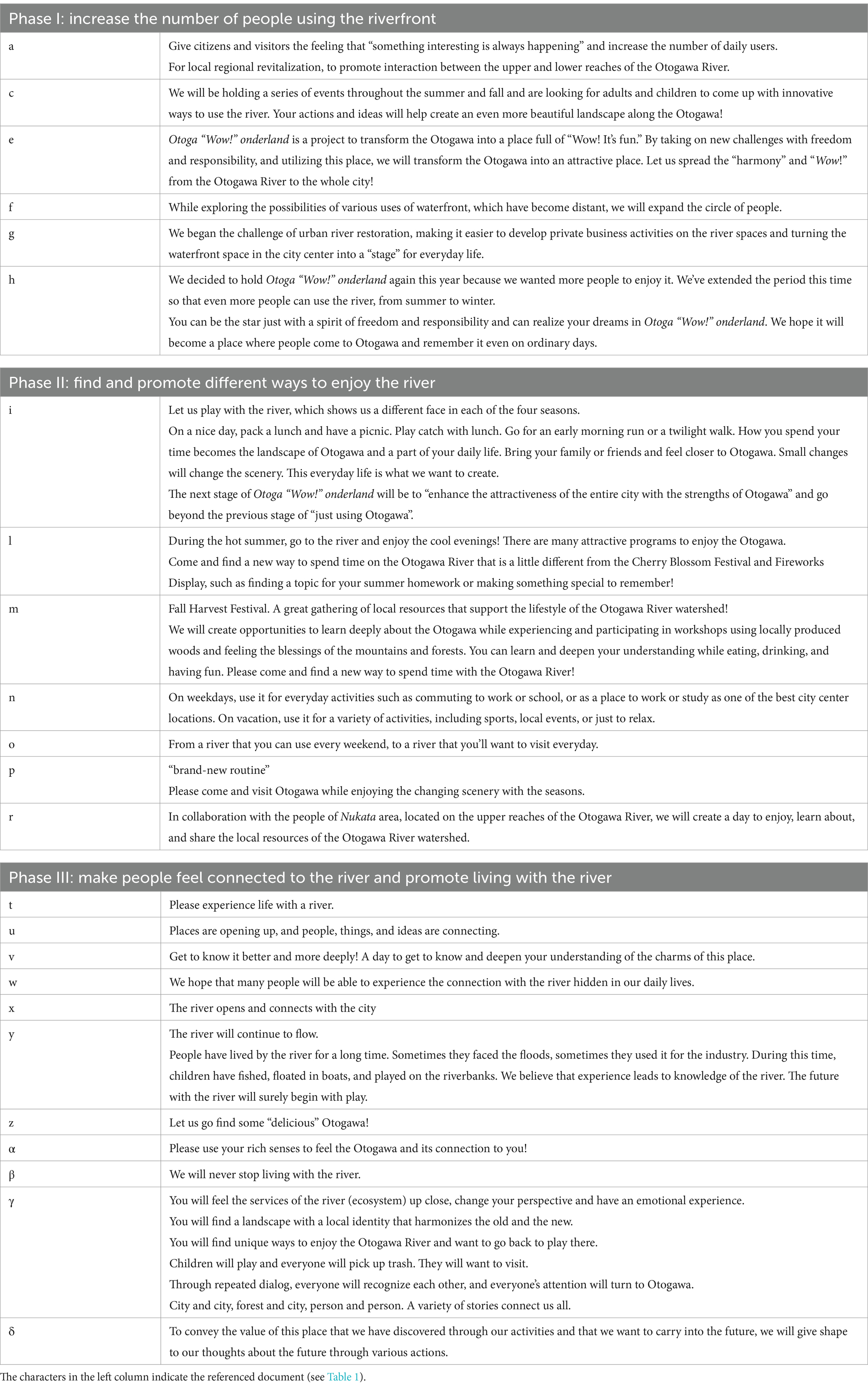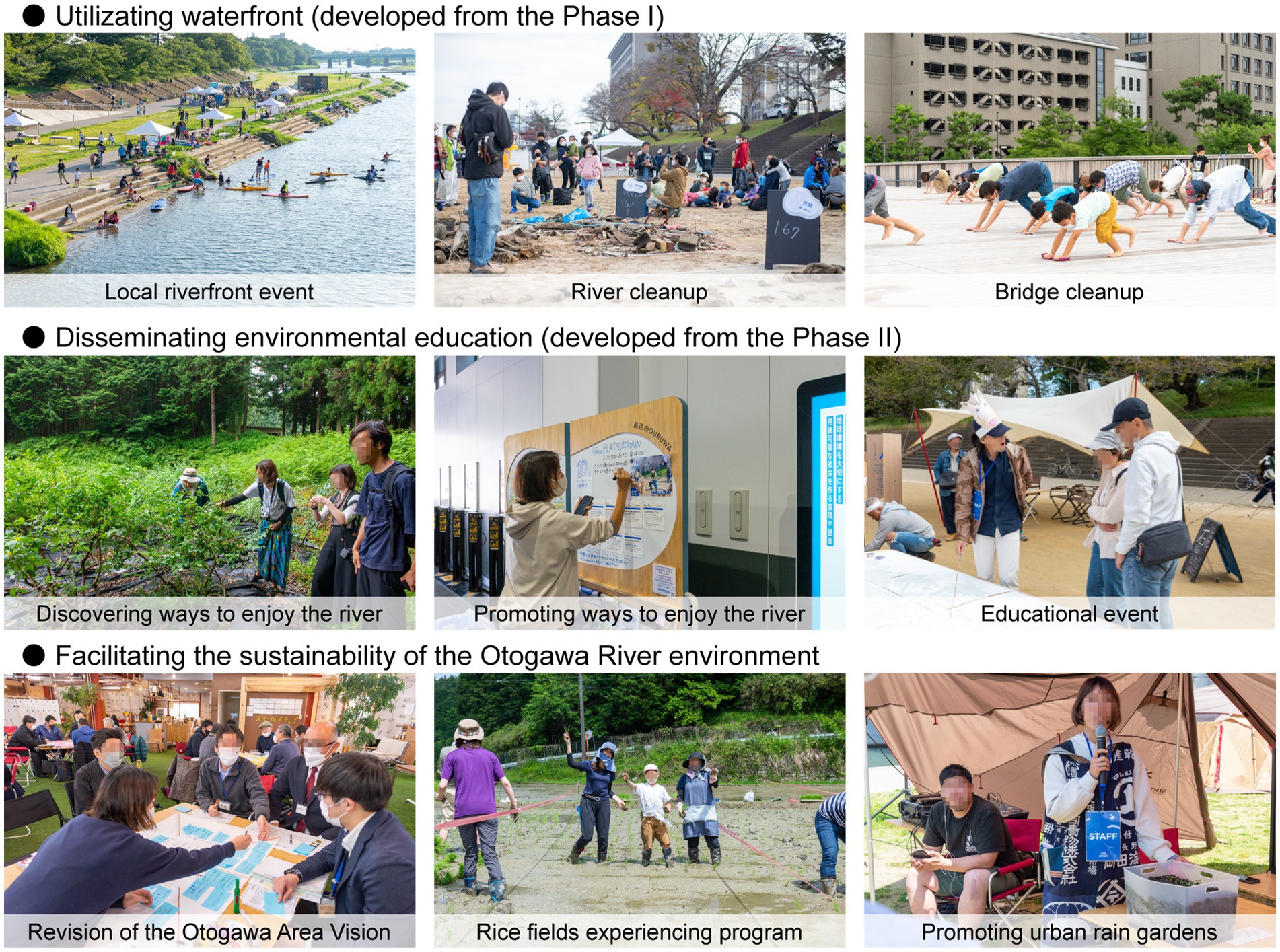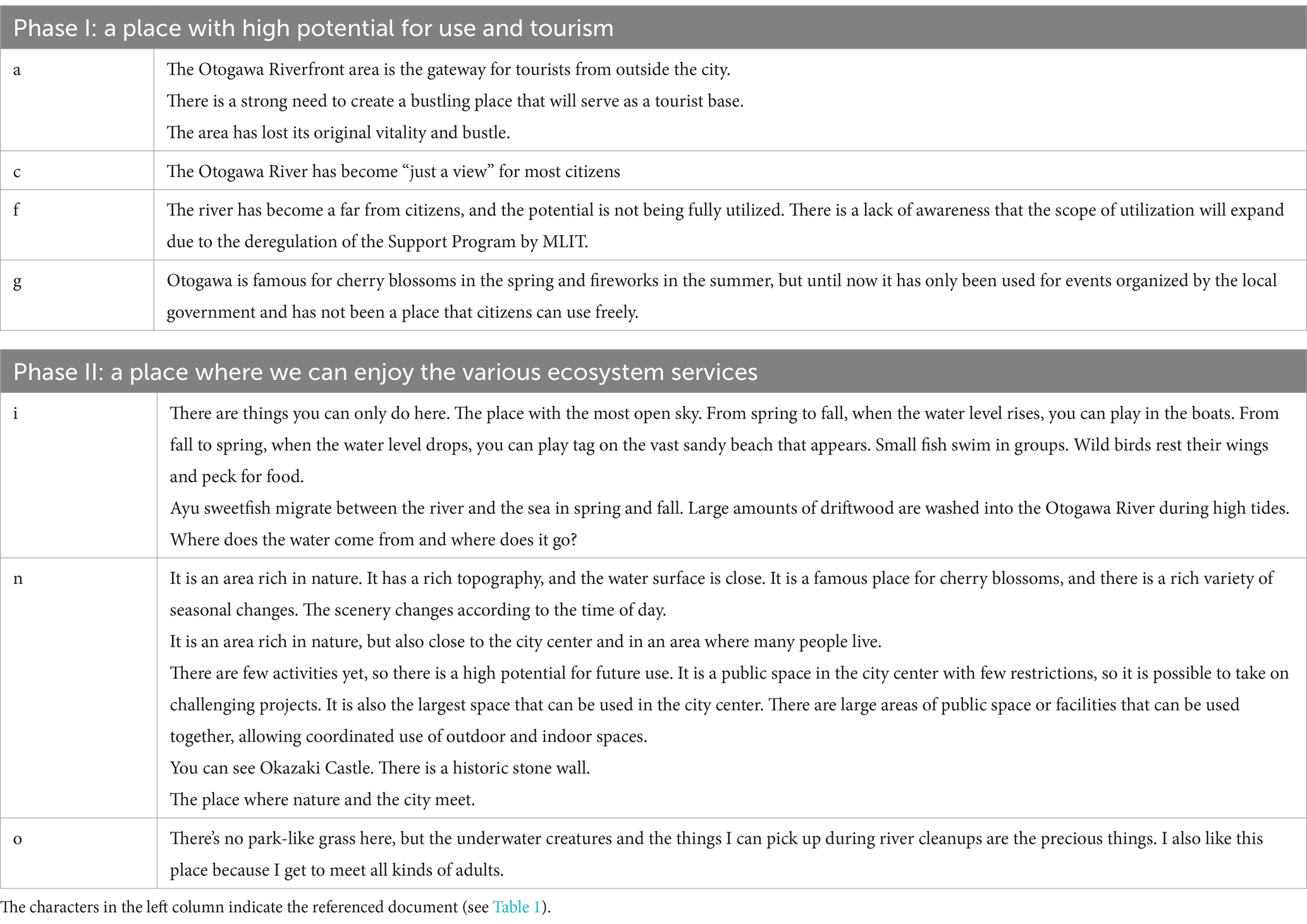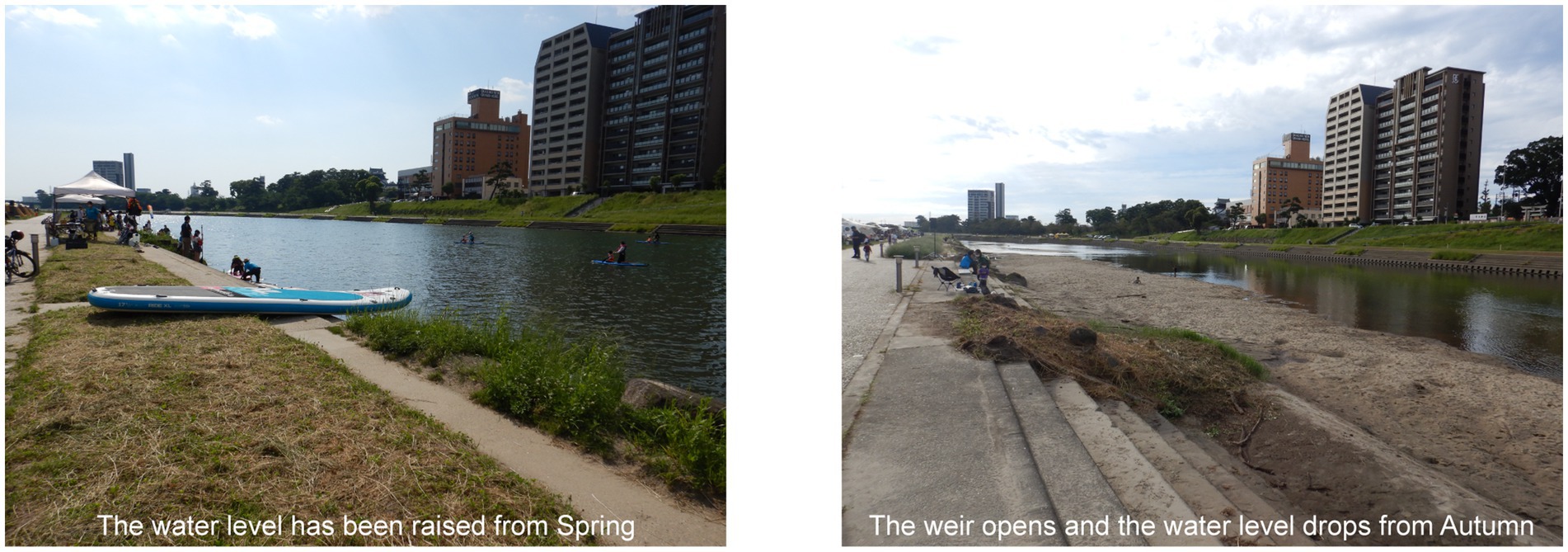- 1Faculty of Social and Cultural Studies, Kyushu University, Fukuoka, Japan
- 2National Graduate Institute for Policy Studies (GRIPS), Tokyo, Japan
This study examined how urban river restoration processes can cultivate a sense of ownership and contribute to community-engaged climate change adaptation, focusing on the case of Okazaki City, Japan. The research employed a qualitative approach, analyzing local documents and interviewing ten key volunteers of ONE RIVER, a local citizens’ group. The case study demonstrated that local activities began with utilizing the river area and subsequently expanded to encompass community-based adaptation, including sustainably maintaining the river environment across the entire watershed. Additionally, it was observed that a sense of ownership over climate change adaptation was cultivated in stages through local activities. The volunteer members first recognized the natural appeal of the diverse river ecosystem services with the rich experiences of the natural dynamics, such as seasonal scenery changes and the presence of living organisms. Secondly, they perceived a hidden connection between the river environment and one’s own life by fostering relationships with a diverse range of stakeholders. Our findings indicated that urban river restoration would benefit community-engaged climate change adaptation by revitalizing the connection between urban society and rivers and building reasonable government-community relationships with local participation. The case study also suggested that considering sociocultural differences is crucial for evaluating the benefits of urban river restoration.
1 Introduction
Urban river restoration can demonstrate a multitude of values to our society from the various aspects of the socio-ecological systems, including economic, cultural, and ecological factors (Sabbion, 2017; Mishra and Saxena, 2024). River restoration improves hydrologic, geomorphic, and/or ecological processes within a degraded watershed, aiming to replace the natural system’s lost, damaged, or compromised elements (Wohl et al., 2015). In particular, river restoration in urban areas aims to regenerate ecosystems and enhance human well-being simultaneously (Zingraff-Hamed et al., 2017). Nevertheless, despite the considerable social and cultural value of rivers in urban areas (Kondolf and Pinto, 2017), there are inherent limitations to the extent to which ecosystems can be improved through enhancements to water quality and riverbanks, primarily due to spatial constraints (Bernhardt and Palmer, 2007).
Therefore, urban river restoration emphasizes environmental education and community building (Kondolf and Yang, 2008). This community development process can demonstrate its latent value to society beyond ecosystem regeneration and well-being. A well-established tenet of environmental education is that cognitive processes are altered by direct natural environment experience (Ardoin et al., 2020). To illustrate, an enhanced comprehension of the river landscape can be achieved through an increase in the frequency of direct experience with the river (Lay et al., 2013). Moreover, prior research has indicated that awareness of water environment issues can be incrementally developed through the processes of urban river restoration in Japan (Nakamura, 2018). There is also a related concept named “stewardship” in the context of environmental conservation (Mathevet et al., 2018). It has been observed that local environmental stewardship is shaped by the progression of action (Takizawa, 2022).
Those values of urban river restorations may contribute to climate change adaptation, particularly in sustainable water resource management, by cultivating a local community’s sense of ownership. Cultivating a sense of ownership over climate change by connecting with local, everyday problems is pivotal in effectively implementing community-engaged adaptation strategies (Simon et al., 2020). In the context of community development, the term “sense of ownership” describes the feeling or perception among community members that they have a stake in the processes and outcomes (Lachapelle, 2008). A mature relationship between governments and communities is one dominant factor that can form a sense of ownership (Nickel and Schnurr, 2024) by promoting community participation. Previous research has demonstrated that meaningful stakeholder engagement in projects is a critical driver of community-engaged adaptation (Kelly et al., 2017). This is sometimes articulated regarding a shared responsibility mindset (Johnston et al., 2022) or elucidated quantitative impacts through the lens of social capital (Hagedoorn et al., 2019). Furthermore, person-place bonding, which enhances people’s interest in the outcomes, should be considered a significant factor (Groulx, 2017). This aspect is more important in urban areas as residents have been observed to demonstrate a reduced sense of place identity over the local environment (Belanche et al., 2021). This is particularly true in developed countries like Japan, where the government actively promotes water resource management and lifestyles primarily disconnected from nature (Nakamura and Oki, 2018). Promoting direct natural environment experience through urban river restoration is considered to have a high potential for contributing to this problem.
However, the potential value of urban river restoration processes for community-engaged adaptation still needs exploration. The integration of climate change adaptation with local community needs (United Nations Development Programme, 2015) and bottom-up approaches (Ayers and Forsyth, 2009) has received considerable attention (Piggott-McKellar et al., 2019), and much research, including theoretical suggestions, has already been presented. For example, the concept of “river culture” posits that recognizing the positive values of healthy rivers for human well-being can address the water resource management problem (Wantzen et al., 2016). It is noted that linking nature-based solutions with community-engaged adaptation would create a synergistic effect (Wamsler et al., 2020). This concept also attracts attention when considering social characteristics at the community level, representing a prominent issue in sustainable development (Clavin et al., 2023). However, there is a critical lack of consensus on the precise definition of “community” (Chung, 2023). Consequently, empirical studies on actual cases typically address community characteristics, such as a sense of ownership and person-place bonding, as boundary conditions and uncontrollable factors, and they tend to investigate the policies or systems of government agencies (McNamara and Buggy, 2017).
The Okazaki City in Japan provides an illustrative example of a local initiative initially focused on urban river restoration that has subsequently expanded to encompass the long-term maintenance of a sustainable environment in climate change, including extreme flooding and drought. A local citizens’ group, designated as ONE RIVER, is engaged in various activities, including river environmental education, forest utilization, rice field experience programs, and urban rain garden promotion. It is anticipated that the sense of ownership over climate change adaptation was cultivated through the expansion of local activities. Consequently, the case study serves as an effective means of verifying the potential value of urban river restoration processes.
In this study, we employed a qualitative approach to examine the expansion process of community-engaged local activities in Okazaki City, Japan, and discuss the potential value of urban river restoration for climate change adaptation. To investigate cultivating a sense of ownership, we conducted a detailed analysis of the process, emphasizing the perceptions and recognitions of the involved participants in the urban river restoration projects. This study addressed the following research question: How can the processes of urban river restoration cultivate a sense of ownership and contribute to community-engaged climate change adaptation? The findings of this study will provide practical and valuable insights for linking nature-based solutions and community-engaged adaptation, which have been noted for their synergistic effects.
2 Method
2.1 Case site: Okazaki City, Japan
2.1.1 Geographical conditions
Okazaki City is one of the core cities in Japan, with an area of 387 km2 and a population of approximately 380,000. Figure 1 illustrates the geographical configuration of the Okazaki City area. The city has developed for eight centuries, establishing itself as a prominent political and economic center for the surrounding region. Approximately 60% of the city area is covered by forest, and most of the population is concentrated on the city’s western side.
Okazaki’s city center comprises two distinct areas: the vicinity of the primary railway station, designated as East Okazaki Station, and the historic district, colloquially known as Kosei District. Since the 1990s, as in many other regional cities in Japan, the city center area has experienced a significant decline in visitors, resulting in urban planning challenges. The primary causes of this phenomenon are the proliferation of suburban shopping malls in response to the growth of motorized transportation and the decline in the residential population of the historic area due to the increasing prevalence of nuclear families. In 2009, the municipal government established an Urban Revitalization Council as a nonprofit organization (NPO). In 2011, it formulated a vision for the future of Okazaki City center (Kosei Historic District and East Okazaki Station Area), including revitalization plans.
Table 1 shows the dimensions of the Otogawa River. Approximately 65% of the total area of Okazaki City (258 km2) is encompassed by the watershed of a single river, the Otogawa River. The river provides approximately 60% of the city’s water supply. The primary headwaters are situated within the municipal boundaries, on Mt. Hongu (789 meters above sea level) and Mt. Tomoe (719 meters above sea level). The watershed is entirely contained within the city limits. This has been the case since the merger of Okazaki City with the former independent local government of Nukata Town in 2006. Concerning flood disaster management, the entire 34-kilometer length of the river is under the purview of the prefectural government (the mid-local level).
The Otogawa River traverses the city center of Okazaki, serving as a prominent public space that defines the city center landscape. However, following a period of accelerated economic growth, the river environment, particularly in terms of water quality, declined, reducing the riverfront’s usage in daily life. Historically, the river was a significant contributor to Okazaki’s economic development, serving as a vital transportation route for shipping. For a minimum of 250 years, the city center has developed on both sides of the Otogawa River. Additionally, it has served a cultural function. Cherry trees have been planted along the levees, and many people enjoy the cherry blossoms in the spring. In August, a fireworks display is held as a traditional local event, launched from boats on the river’s surface. Figure 2 depicts a historical image of the fireworks display and a recent cherry blossom viewing party. As of 2015, these two events represented the primary opportunities for citizens to utilize the Otogawa Riverfront.
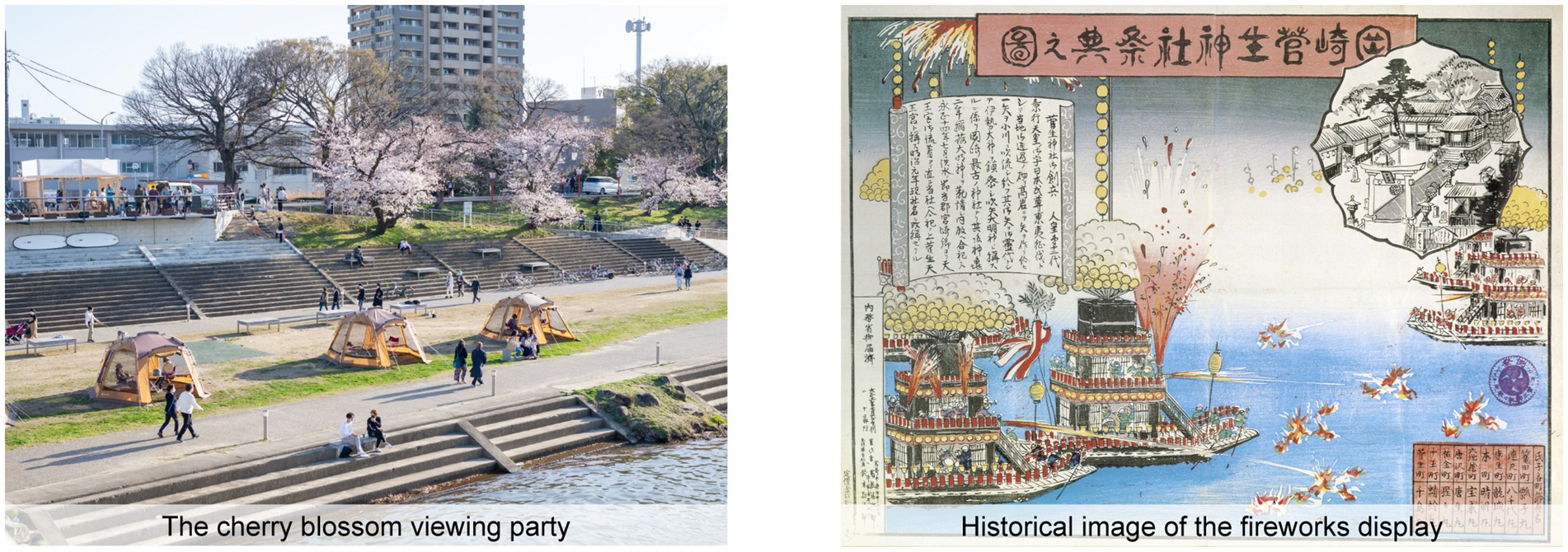
Figure 2. Major local events (fireworks and cherry blossoms) on the Otogawa River flowing through Okazaki City center. The photo left was provided by ONE RIVER, and the picture right was provided by Sugo Shrine, Okazaki City, Japan.
2.1.2 Social context of river restoration and community participation
In August 2014, the municipal government devised the Otogawa Riverfront Area Improvement Plan. The plan aims to revitalize the city center by restoring the Otogawa River environment and promoting its daily use. The specific strategy is to enhance the connectivity between the southern area near the central station and the northern historic district by facilitating the utilization of the Otogawa River area.
Figure 3 shows the process of urban river restoration and community participation in the Otogawa River case. The plan represented the fulfillment of campaign promises made by the newly elected mayor of Okazaki City, who assumed office in October 2012. Figure 4 depicts the implemented enhancements to the riverfront area, including the construction of a park adjacent to the waterway, the creation of a riverside promenade, the addition of a new pedestrian bridge, the installation of a boat launch and ramp for boat use, and the establishment of a shelter for storing materials on the riverbank (designated as RiverBase). Furthermore, a pedestrian walkway and central greenway were designed to improve accessibility from the main station and Kagoda Park, a significant urban green space. A top-down process guided the development. The plan was reviewed by the Otogawa Riverfront Council, a group of experts and local stakeholders constituted by the municipal government. The council convened six public meetings during the 2013 fiscal year and presented a comprehensive proposal to the city authorities in February 2014. In April 2014, a fundamental policy was formulated based on the proposal and subsequently integrated into the plan’s content. Furthermore, the plan was financed by the national government and executed over five years, concluding in 2020.
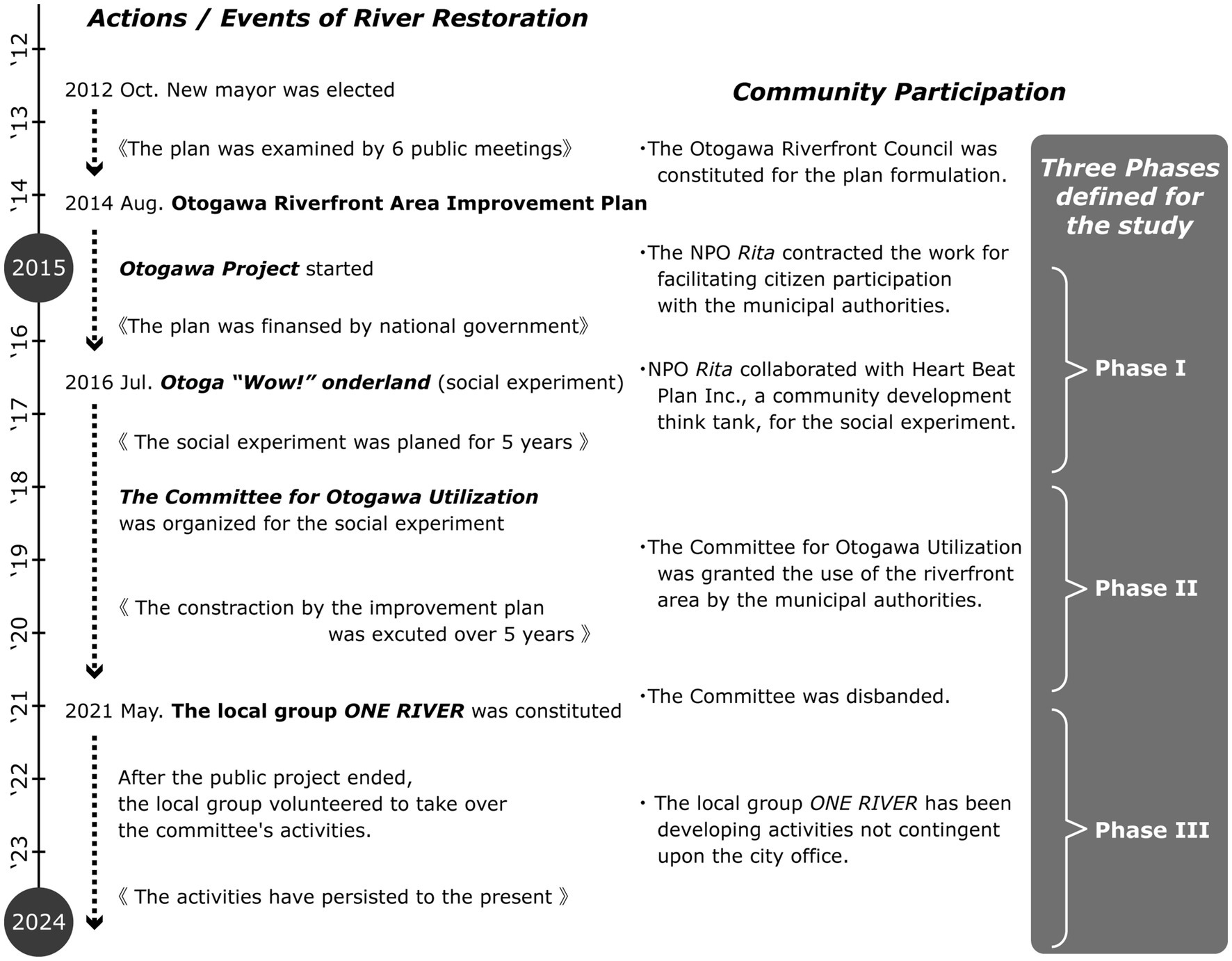
Figure 3. Chronological order of the process of urban river restoration and community participation in the Otogawa River case.
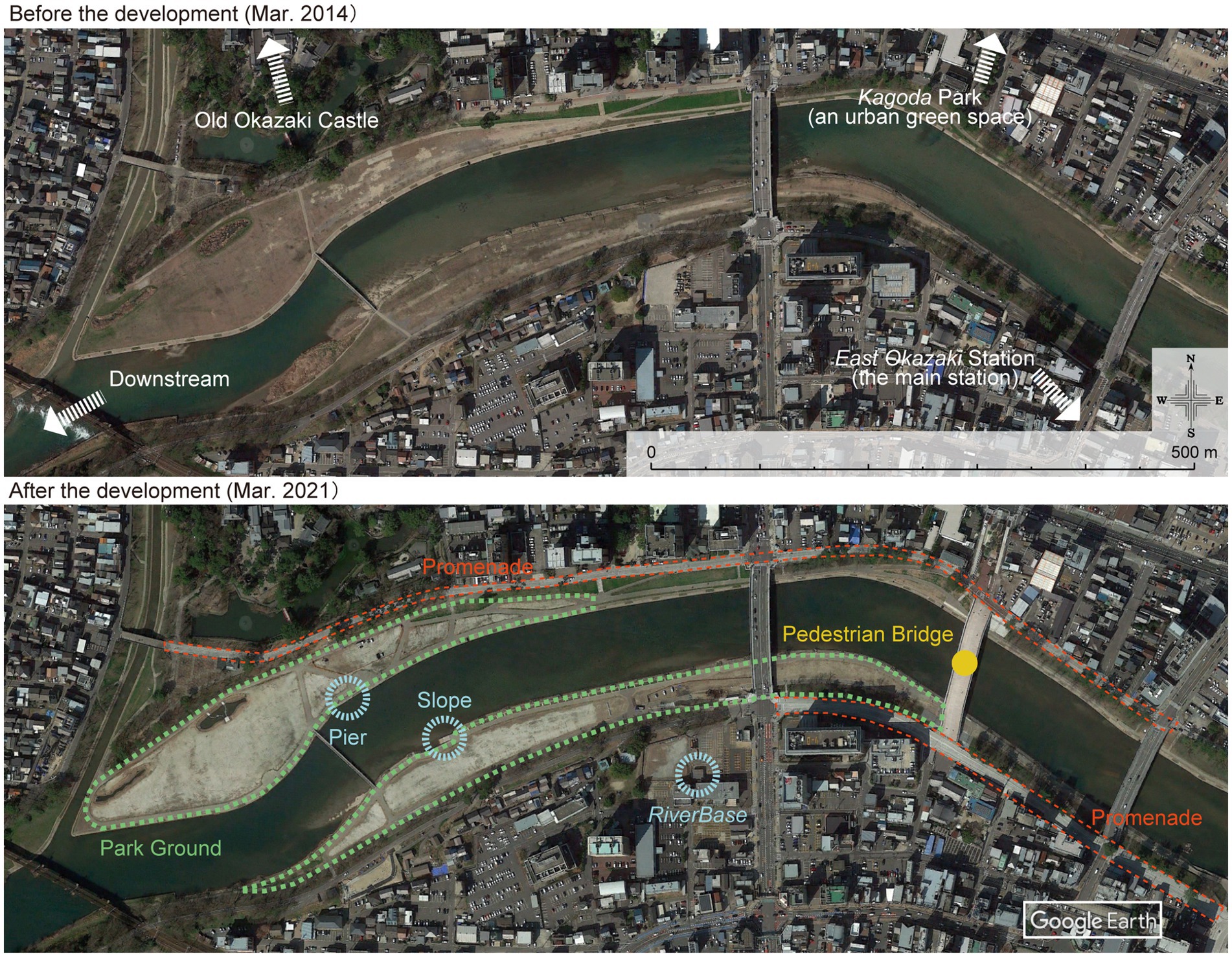
Figure 4. Otogawa River around the Okazaki City center before and after implementation of the Otogawa Riverfront Area Improvement Plan (made with Google Earth Pro).
In 2015, the plan’s implementation coincided with an initiative to encourage local community participation, which proved to be a significant factor in promoting the use of the space. Community participation has continued to the present day. While the membership structure has been continued and expanded, the organizational structure has undergone modifications. In 2015, the municipal government initiated the Okazaki and Otogawa Riverfront Project Community Development Design Project, which is also referred to as the Otogawa Project. In this context, the nonprofit organization (NPO) Rita, specializing in local development, played a pivotal role in recruiting participants and fostering community engagement. Concurrently, the project was registered under the River Improvement Support Program by the Ministry of Land, Infrastructure, and Transport (MLIT), the national government, in March 2015. The objective of this registration was to facilitate the deregulation of the utilization of river spaces. In 2016, NPO Rita collaborated with Heart Beat Plan Inc., a community development think tank based in Osaka, Japan, to launch a five-year social experiment called Otoga “Wow!” onderland (meaning “Otogawa” and “Wonderland”). The team was disbanded in 2018, at which point the Committee for Otogawa Utilization, an independent group of the participants in the project, was established and proceeded to organize Otoga “Wow!” onderland. Following the project’s conclusion in March 2021, the local group ONE RIVER was constituted in May 2021 and assumed the committee’s activities, and it has persisted to the present.
2.2 Data collection
This study collected data by reviewing pertinent local documents and interviewing key local group ONE RIVER members. The local group ONE RIVER is a voluntary organization made up of neighbors. This means that ONE RIVER is not an NGO or an NPO; instead, it is simply a community group that engages in activities and collaborates.
The 31 documents subjected to review are itemized in Table 2. ONE RIVER provided the documents. The Otogawa Grand Design Log is the public report of the Otogawa Project by the Okazaki City Office. The NPO Rita supervises the documents, and one of the purposes of publishing them is to announce and promote local community activities. “The Otogawa Riverfront Area Community Development Design Concept: The Citizen’s Proposal” was developed to advance the Otogawa Riverfront Area Improvement Plan. The local community was subjected to review through the workshops. The OTONOTO booklet provides a comprehensive account of the activities undertaken by Otoga “Wow!” onderland over a year, as observed and reported by the Committee for Otogawa Utilization. The “Otogawa Area Vision” is a publicly available document that delineates the prospective utilization of the Otogawa River Area. It outlines the area’s objectives, planned initiatives, management frameworks, and operational procedures. These elements were collectively devised by a designated working group collaborating with the local community.
These texts were intended to promote their activities and Otogawa to the general public. Each document announces or reports on local activities related to urban river restoration. The text was extracted from the materials, excluding information such as the dates and locations of activities, program introductions, and introductions of the people involved.
The subjects of the interviews were ten individuals currently members of the local ONE RIVER group. The specific means of the interview are as follows. At first, an interview was conducted with the group’s project manager, who has been a critical player in this case since 2017. This was held online in September 2021. The questions were composed of the following: about the circumstances leading up to the launch of the ONE RIVER, for example, the changes in policy and activities, the awareness raised through the activities, and the events that triggered them; and about the motivation for the current activities. The dialog was recorded on the application system and transcribed by the lead author. Next, the manager proceeded to introduce the other core members. The remaining nine interviews were conducted in person between August and December 2022. We asked them how each member came to participate in the local activities of the urban river restoration, their past experiences, and their current motivations. With the interviewees’ permission, the conversation was recorded by IC recorders and automatically transcribed using the AI application “CLOVA NOTE” provided by LINE WORKS Corp. All interviewees and authors were native Japanese speakers, and the interviews were conducted in Japanese.
2.3 Analysis
In this study, we analyzed the attitudes of volunteer members of the local group ONE RIVER, who participated in the urban river restoration project, rather than the trend of attitudes of the general public. This was because it would be feasible to analyze, as the survey subjects were easy to establish, and the change in attitudes was more rapid and more straightforward to capture. To verify the effectiveness of promoting climate change adaptation, we should analyze the sense of involvement of the public citizens, not just some group members, but there are many methodological limitations.
Figure 5 describes a conceptual model of the contribution of urban river restoration to climate change adaptation based on previous research and correspondence with the analysis methods of this study. A sense of ownership is assumed to be cultivated by two dominant factors: government-community relationship (Nickel and Schnurr, 2024) and person-place bonding (Groulx, 2017). This study focused on forming person-place bonding through direct natural environment experiences of rivers to analyze the contribution of urban river restoration. Therefore, the experiences and perceptions of rivers and person-place bonding of the participants in the urban river restoration project were analyzed using the results of a literature survey and interview survey. On the other hand, the government-community relationship was considered a boundary condition determined by community participation policy.
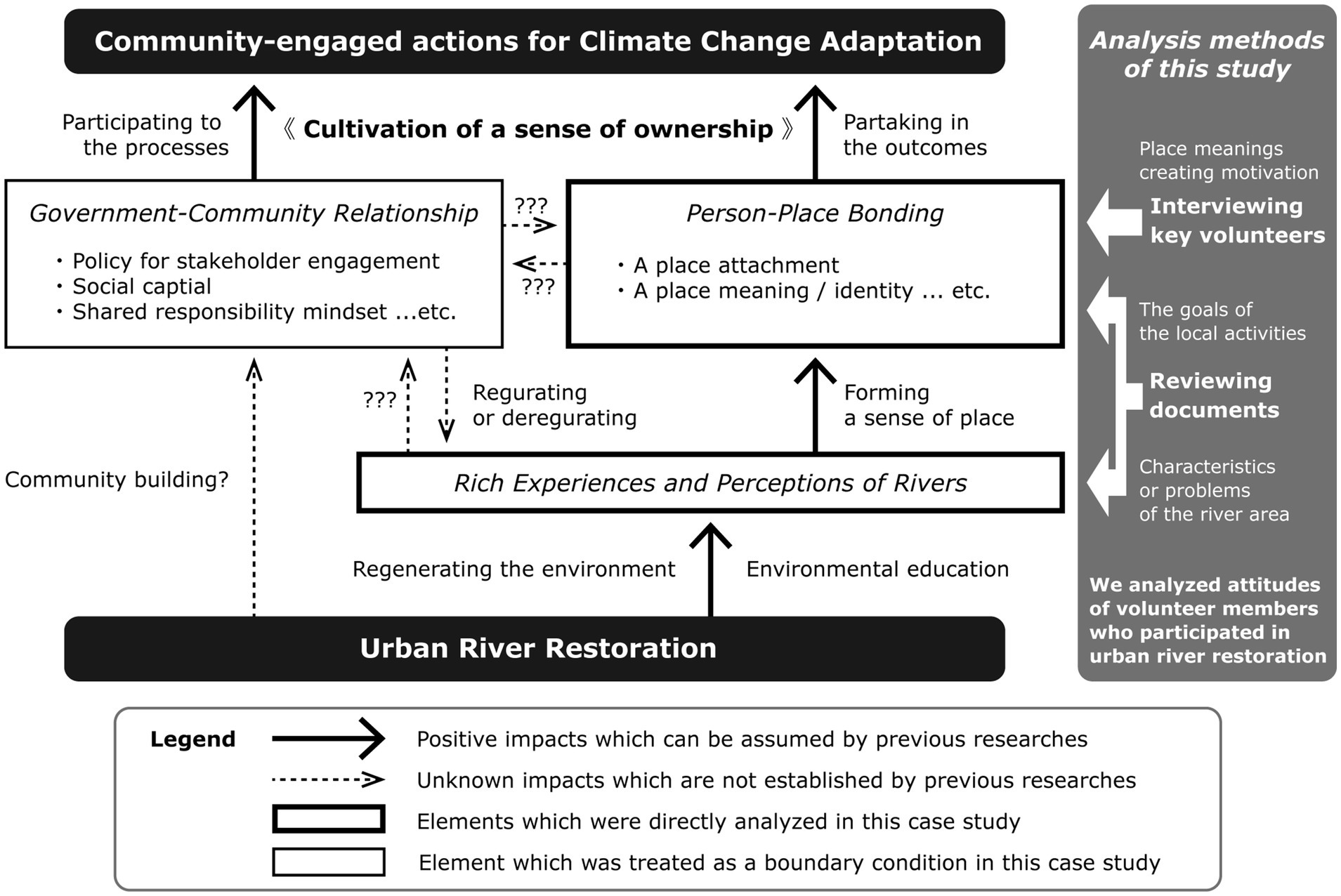
Figure 5. Conceptual model for the urban river restoration contribution to climate change adaptation through the cultivation of a sense of ownership.
The documents were analyzed to establish the volunteer members’ perceptions of rivers and person-place bonding. The target texts were analyzed according to two content areas: the first category pertains to the goals of the local activities (3.1). In contrast, the second category pertains to the characteristics or problems of the Otogawa River area (3.2). The former represents the volunteer members’ prospective vision of the Otogawa River area, reflecting the characteristics of their person-place bonding. Whereas the latter represents their perceptions of its potential services, reflecting the characteristics of their experiences and perceptions of the Otogawa River. The authors themselves translated the texts into English.
The results of the interviews were used to analyze each participant’s person-place bonding. We extracted content that indicates place meanings of the Otogawa area from the statements about the motivations for participating in the activities. We used the grounded codes shown in Gernow et al. (2024) for coding methods of place meaning, such as nature, well-being, and symbols. For example, we classified the following statement, “I cannot help to go in the river, because I like being in nature.” to nature, but “The large river space of the Otogawa is the precious charm of this area that can be perceived easily.” to symbols. We carried out all of these tasks manually in Japanese. No specific coding software was used.
For analysis, we defined this case’s three phases of urban river restoration processes in the ten years from 2015 to the present. Each phase is associated with changes in the policy of community participation. This is because the policy has determined the characteristics of the government-community relationship. Moreover, as the organizational structure evolves, the content and objectives of the activities are also subject to reevaluation, and the sense of the participating members at the time is thought to be reflected in the activities. Therefore, we thought this approach was appropriate for analyzing volunteer members’ attitude changes by document review.
Table 3 illustrates the division of phases in this study. The characteristics in each phase were compared to analyze the changes in the volunteer members’ attitudes (3.3). The characteristics of the community participation policy in each phase are as follows. In Phase I, the city government of Okazaki contracted the responsibility of facilitating citizen participation in the NPO Rita. In Phase II, the municipal authorities granted the use of the riverfront area to the Committee for Otogawa Utilization, which spearheaded activities. Finally, in Phase III, the local group ONE RIVER has been developing activities that are not contingent upon the city office.
3 Results
3.1 Descriptions of the goals of the local activities for each phase
Table 4 presents a list of the descriptions of the stated goals of the local activities outlined in the reviewed documents (Table 2). The distinctive descriptions were identified in the goals of the local activities for each phase and will be discussed in greater detail below.
In Phase I, the primary objective of local activities was to increase the number of people using the riverfront. Therefore, the key term was “fun.” This phase aimed to promote the Otogawa Riverfront Area Improvement Plan to revitalize the decaying city center. To enhance the vitality and vibrancy of the city center and utilize the river spaces, it was strongly encouraged that various people with the potential to use the riverfront, including adults and children, participate. For example, between January and March 2016, three project workshops entitled “Small but Fun Meetings for the Otogawa Revolution” were conducted to assemble potential users of the riverfront area to deliberate on the possibilities for the riverfront. As a result, the Otoga “Wow!” onderland was successfully held, with 32 groups participating. In 2017, the number of participating groups decreased to 24. However, several events commenced regularly, including the Otogawa Night Market, Otogawa Stargazing, Fresh Vegetable Morning Market, and Otogawa River Cleanup.
In Phase II, the objective was to find and promote different ways to enjoy the river. The Committee for Otogawa Utilization sought to identify and disseminate information regarding novel and varied methods of enjoying the river through the Otoga “Wow!” onderland. In addition to utilizing the river for temporary events such as fireworks displays and cherry blossom viewing, the committee also promoted the everyday use of the riverfront. In particular, the committee ensured that the event flyer was updated monthly, publicizing different ways to enjoy the river depending on the season. Moreover, the committee published and distributed a one-year activity report booklet for citizens entitled “OTONOTO,” highlighting various underutilized aspects of the Otogawa River (Figure 6). Since 2019, the committee has initiated several new Committee-led projects, including the “Let it Camp” riverfront camping initiative and “Kawa-biraki” in the spring as an opening event, “Kawa-asobi” as a summer event, and “Kawa-gurashi” as an autumn event. These integrated programs employed a multifaceted approach to promote diverse riverine activities.
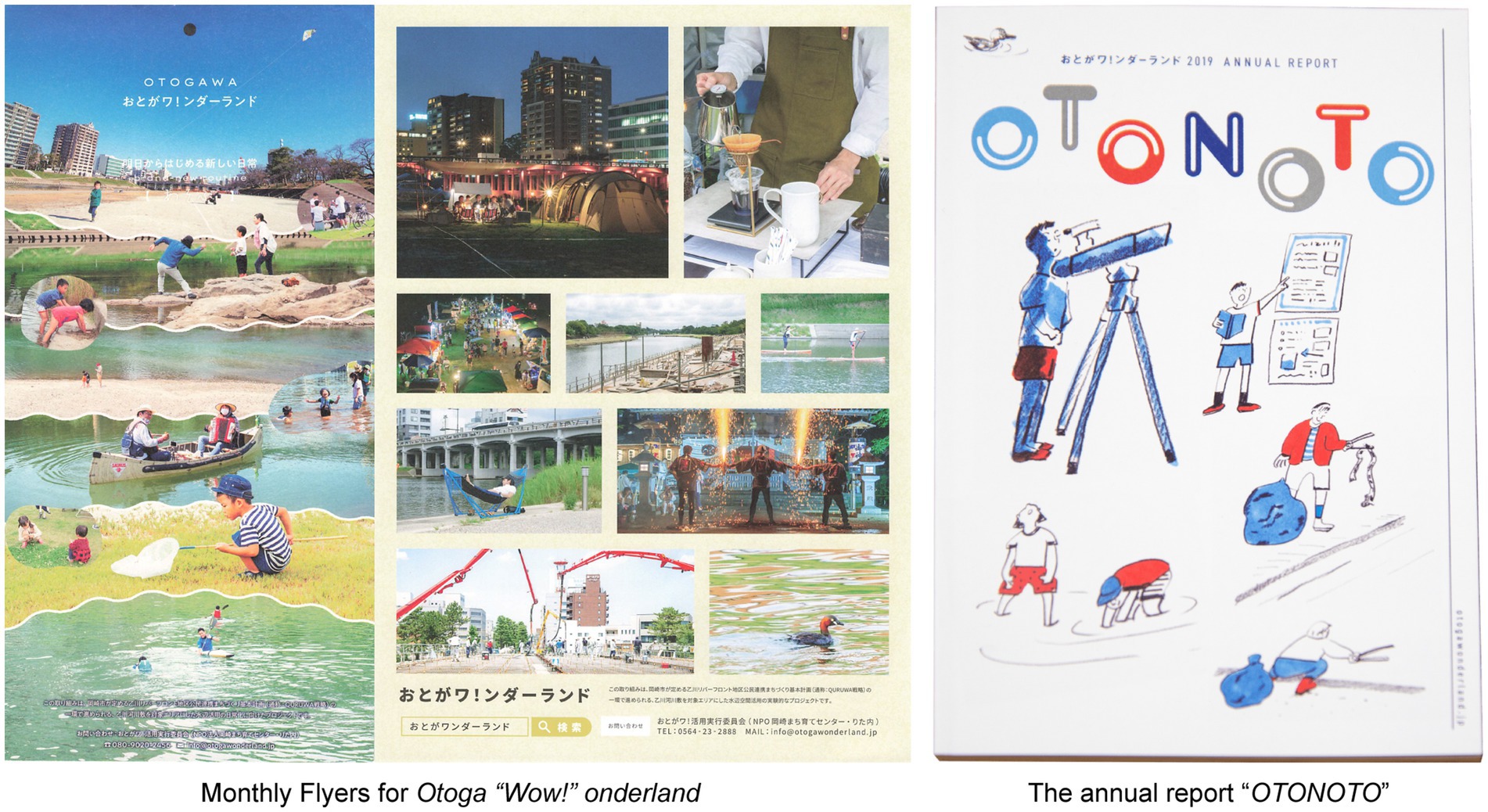
Figure 6. Flyers and leaflets for promotion of the Otogawa River’s attractions. The documents themselves were provided by ONE RIVER.
In Phase III, the goal has been to make people feel connected to the river and promote living with the river. Figure 7 illustrates the local activities of ONE RIVER. The activities have undergone a notable diversification of content, evolving into an organization that is not constrained by the parameters of the city’s public projects. The activities included the revision of the “Otogawa Area Vision,” promoting urban rain gardens for rainwater storage, and using rice fields in the upper reaches of the Otogawa River. These activities were not merely intended to utilize the waterfront or disseminate environmental education but to facilitate the sustainability of the Otogawa River environment. Initiatives from Phase II, such as local events and the discovery and promotion of diverse ways of enjoying the river through educational programs, continued and developed from the Otogawa riverfront around the city center area to the entire watershed. The fundamental principle of ONE RIVER is encapsulated in the phrase “carry into the future.” Additionally, the word “future with the river” was employed in one of the flyers disseminated for the events, indicating that the group sought to appreciate the river in the present and coexist with it in the future.
3.2 Descriptions of the characteristics or problems of the Otogawa River area
Table 5 lists the characteristics or problems of the Otogawa River area as outlined in the reviewed documents (Table 2). As illustrated in the following section, the potential services of the Otogawa River were perceived differently during Phases I and II. However, no related descriptions were identified in Phase III.
In Phase I, the volunteer members perceived the Otogawa River area as a place with high potential for use and tourism. This was consistent with the rationale behind the Otogawa Riverfront Area Improvement Plan. The findings indicate that both the municipal government and the local community have acknowledged the potential of the Otogawa River as a public space that has shaped the landscape of Okazaki’s city center. Additionally, they have identified an urban planning issue: the Otogawa River area has not been utilized and has become a mere view for most citizens. The deregulation of the river’s usage by the national policy of MLIT has further reinforced this awareness.
In Phase II, the volunteer members identified the Otogawa River area as a place where people can enjoy the various ecosystem services. The findings indicated that the perceptions of the services provided by the river ecosystem differed from those of other urban parks. The statement exemplified this, “There are things you can only do here.” Additionally, the descriptions of living things (e.g., “Small fish swim in groups. Wild birds rest their wings and peck for food” or “It is an area rich in nature”) and temporal changes in the scenery (e.g., “From fall to spring, when the water level drops, you can play tag on the vast sandy beach that appears” or “there is a wide variety of seasonal changes”) suggested that the distinctive natural dynamics of river ecosystems are acknowledged as the defining feature of the Otogawa River area, situated within an urbanized city center.
These perceptions of the Otogawa River area are consistent with the stated goals of the activities, as revealed in section 3.1. In other words, these perceptions can be understood as factors that shape the characteristics of the activities. In Phase I, efforts were made to increase the number of individuals utilizing the Otogawa River. This was driven by the awareness of the river’s significant potential for utilization. In contrast, Phase II saw the identification and promotion of diverse avenues for river enjoyment. This was prompted by the realization that the Otogawa River offered distinctive enjoyment.
3.3 Changes in the involved participant’s perception
3.3.1 Recognizing the diversity of river ecosystem services (phases I to II)
As the activities progressed from Phase I to Phase II, the volunteer members shifted in perception, demonstrating an increased awareness of the potential for the multiple services of the Otogawa River area. As shown in 3.2, in Phase I, many descriptions centered on the concept of “fun” and assumed that the leading service provided by the river was the use of the riverfront area. However, in Phase II, there were more descriptions related to living things and temporal changes in the scenery. The use of the riverfront area was similarly promoted in both phases. Therefore, the change in the trend of the descriptions shows the change in the perceptions of the volunteer members.
In Phase II, conceived as a public space within the city center, the Otogawa River had become a natural interface supporting various living and seasonal creatures. Both the Okazaki City government and the general public perceived it as a valuable public space. However, the diverse ecosystem services it provides had yet to be widely recognized. In light of this, the Committee of Otogawa Utilization developed a series of initiatives to share its perceptions of the Otogawa River with citizens.
The project manager of the ONE RIVER yielded two reasons for recognizing the river’s multifaceted ecosystem services. First, the river has been utilized consistently throughout the year since 2018, and the members experienced seasonal fluctuations in water levels. Second, the members realized that the irrigation weir had been operated for the upstream migration of the Ayu sweetfish (Plecoglossus altivelis, 1846).
Table 6 illustrates the number of event days, total duration, participating groups, programs, and visitors to the Otoga “Wow!” onderland from 2016 to 2020. The actual duration of Otoga “Wow!” onderland in 2018 was 304 days, representing a significant increase from the 48 days observed in 2016 and the 196 days observed in 2017. As the text “The next stage of Otoga “Wow!” onderland will be to ‘enhance the attractiveness of the entire city with the strengths of Otogawa’ and go beyond the previous stage of ‘just using Otogawa,’” indicates the transition to the next phase of Otoga “Wow!” onderland in 2018. This decision was made for two reasons. Firstly, the summer vacation is typified by elevated temperatures, which present a challenge for comfortably facilitating outdoor activities. Secondly, there has been a notable increase in the number of programs that have expressed interest in holding regular events. In response, two committee members were assigned to be stationed at RiverBase, located on the riverfront, from 2019 to 2020. Their role was to encourage daily use and support players in their activities. The primary stakeholders demonstrated a growing interest in the distinctive features of the Otogawa River, including the seasonal changes in water levels and scenery.
Figure 8 depicts the topographical characteristics of a certain location on the Otogawa River during the summer and winter seasons. The water level of the Otogawa River in the vicinity of the city center displays a seasonal variation, with higher levels observed during the summer and lower levels during the winter. This is because the downstream weir is closed during the summer and open in winter. The weir has been employed for agricultural water intake, situated at the confluence point with the Yahagi River, approximately 3 km downstream from the city center. From April to October, when the water level is high, various activities on the water surface, including boating and stand-up paddleboarding (SUP), can be undertaken. However, when the water level declines, the usability of the surface of the water is significantly diminished. In this regard, a member of the NPO Rita initially expressed the hope that the water level would be maintained at a consistent level throughout the year. However, if the water intake weir were closed in the autumn season, the migration of the Ayu sweetfish would also be impeded, resulting in a deterioration of the ecosystem. From an ecosystem conservation perspective, it was of the utmost importance that the weir be reopened following the summer season. Upon learning of this, the project manager of ONE RIVER began to perceive the river as a natural habitat for living creatures, distinct from the urban park, which can be utilized at one’s discretion. The following phrase in a document in Phase II, “There’s no park-like grass here, but the underwater creatures and the things I can pick up during river cleanups are the precious things” (Table 5, o) suggests that other volunteer members also tended to start perceiving the river as a natural environment from Phase II.
3.3.2 Recognizing the hidden connections with the one’s own life (phases II to III)
In the transition from Phase II to III, the objective of local activities has undergone a significant shift. Whereas the focus in Phase II was on the immediate enjoyment of the river, in Phase III, a broader, long-term vision of sustainable lives in harmony with the river emerged. The autonomous status of the organization has also enabled an expansion in the scope of activities to encompass the entire river basin, which is no longer constrained by the requirements of municipal government administration. Consequently, their activities have been expanded to include harnessing the potential of forests and rice paddies to ensure the sustainable maintenance of the river environment within the river basin.
The impetus for the establishment of ONE RIVER and the continuation of the previous activities that had been conducted until that point was the recognition of the profound connection between local communities and the surrounding river ecosystems. In the interview, the project manager stated, “Our activities led us to develop an affinity for the Otogawa River, and subsequently, we recognized the necessity to gain a more profound comprehension of the local lives and their identities that the river sustains.” This sentiment is encapsulated in the ONE RIVER principle, “to convey the value of this place that we have discovered through our activities and that we want to carry into the future.”
As indicated in the interview, the primary motivations for the ONE RIVER members to engage in local activities can be classified into two categories. One such motivation is the realization that human existence is inextricably linked to nature. Eight of the nine core volunteers described the place meanings of Otogawa as nature. Moreover, six of them elucidated the relationship between nature and their lives in many ways. These included the following statements: “The river connects the whole of Okazaki City,” “I believe it is beneficial to discover one’s own life through one’s relationship with nature,” and “You and everyone are also natural.” This is consistent with the observation that “connection” is a recurring theme in the Phase III text. A representative assertion is “the connection with the river hidden in our daily lives.” The term “hidden” suggests that the volunteer members became aware of previously unperceived connections because of their activities. Another factor is the attachment to the original landscape of the Otogawa River, which they have been familiar with since childhood. This was evidenced by local people in their 60s, who described the place meanings of Otogawa as symbols or landscapes. They recalled that during their childhood (in the 1970s), there were no swimming pools at their educational institution, and engaging in activities within the Otogawa River was a customary aspect of their daily routine.
The project manager of ONE RIVER indicated that the impetus for this realization came from the discussions among participants from various backgrounds. These backgrounds include community development, as shown by event organizers and vendors using the river space, and primary industries like forestry, agriculture, and fishing. Additionally, there are local historical industries such as fireworks, dyeing, and sightseeing boats. The group’s engagement with these diverse perspectives fostered a comprehensive understanding of the river’s ecosystem services, facilitating the recognition of the intricate connection between local industries and the river. One illustrative example was the interaction with forestry businesses. The Otogawa River basin is a small-scale area within the Okazaki City boundary, which facilitates an understanding of the relationship between the state of the forest and the environment of the Otogawa River. In particular, the project manager of ONE RIVER gained insight into the connection between urban flooding, which is expected to worsen due to climate change, and the forest via the river. The following phrase in a document in Phase III, “People have lived by the river for a long time. Sometimes they faced the floods, sometimes they used it for the industry” (Table 4, y) suggests that other volunteer members also tended to start perceiving the connection between the river and one’s own life from the flood perspective from Phase III.
4 Discussion
The study demonstrated that local activities in Okazaki City began with restoring the urban river and subsequently expanded to encompass community-based adaptation. The activities of the local group, ONE RIVER, had multiple objectives. In addition to utilizing the waterfront and disseminating environmental education, they aimed to sustainably maintain the river environment across the entire watershed. These initiatives included reducing the risk of future disasters such as flooding and drought. Their entirely bottom-up approach and consideration of local needs represent the characteristics of community-engaged adaptation (United Nations Development Programme, 2015; Ayers and Forsyth, 2009).
The study also suggested that urban river restoration processes cultivated a sense of ownership over climate change adaptation. This conclusion is supported by a previous study demonstrating that a sense of ownership is essential for implementing community-engaged adaptation actions (Simon et al., 2020). As mentioned earlier in Section 3.3, the ONE RIVER group members identified the hidden connections between themselves and the river through rich river experiences and communication among the various participants. Concurrently, the ONE RIVER initiatives facilitated the sustainability of the Otogawa River environment. The phenomenon observed in this case study aligns with the conceptual framework summarized in Figure 5.
The results of this study demonstrated that a sense of ownership has been cultivated in stages. In Phase I, the natural appeal of the river was reaffirmed, and in Phase II, the communities perceived a connection with the river. These findings are in alignment with previous research on environmental stewardship. Similarly, Takizawa (2022) examined the formation of local environmental stewardship in three urban waterfronts in Japan, delineating five stages: community building, visioning, planning, system development, and local governance. In this case study, the formation of a sense of ownership corresponds to the initial “community building” process, which includes two sub-processes: (1) stakeholders’ understanding of the field is deepened, and (2) relationships between actors are nurtured, and social capital is strengthened. Each of these corresponds to Phase I and II. Phase III corresponds to visioning, and the focus of activities is extended to the future, resulting in community-engaged adaptation actions.
The phenomenon of recognizing the hidden connections with one’s life observed in Phase II because of fostering relationships with a diverse range of stakeholders has also been identified in previous research on community-engaged adaptation. For example, it has been demonstrated that social capital positively impacts adaptation actions (Hagedoorn et al., 2019). Furthermore, when participation is effective, communities have a greater sense of ownership (Kelly et al., 2017). This study also corroborated the suggestion that encouraging the involvement of multiple stakeholders and elucidating the relationships among various stakeholders and the surrounding environment can effectively enhance the sense of ownership.
In contrast, the significance of recognizing the diversity of river ecosystem services, identified in Phase I, had yet to be emphasized in previous research. In the case of Okazaki, the experience of the natural dynamics, such as seasonal scenery changes and the presence of living organisms, led the local community to re-appreciate the river as a natural environment. This re-appreciation constituted the foundation for the involvement of stakeholders with diverse backgrounds. Prior research has indicated that accessibility to waterways is a significant factor in identifying issues related to the ecosystem environment (Nakamura, 2018). In this instance, the Otogawa Riverfront Area Improvement Plan, a top-down political decision, vigorously promoted the use of the river, compelling the local community to utilize it. This facilitated the discovery of the river’s appeal by the involved individuals and led to its recognition.
Figure 9 illustrates a conceptual methodology model aimed at fostering a sense of ownership through community-building processes in urban river restoration efforts. In this case study, the gradual enhancement of group members’ cognitive understanding of the diversity of river ecosystem services and their hidden connections to individual lives established the groundwork for a sense of ownership over climate change adaptation activities. However, this gradual shift was neither intended nor planned. To ensure the effective integration of urban river restoration within community-engaged adaptation strategies, it is essential to consider the following two principles. First, the primary role of urban river restoration is to revitalize the connectivity between urban society and rivers in both spatial and social dimensions (Kondolf and Pinto, 2017), making nature’s dynamic processes accessible while enhancing participants’ awareness of the multifaceted nature of riverine ecosystem services, as evidenced in Phase I. Additionally, flexible approaches to encouraging community participation in response to shifts in participants’ perceptions are necessary to maximize the effectiveness of urban river restoration. In the early stages, increasing the number of participants is critical. Following that, fostering communication among various stakeholders is more effective in enhancing person-place bonding. Furthermore, independence from government oversight is also essential to broaden activities related to climate change adaptation. Even if the project starts with a top-down decision, community involvement can be strengthened throughout the process (Kondolf and Yang, 2008), and the experience of river ecosystems is encouraged.
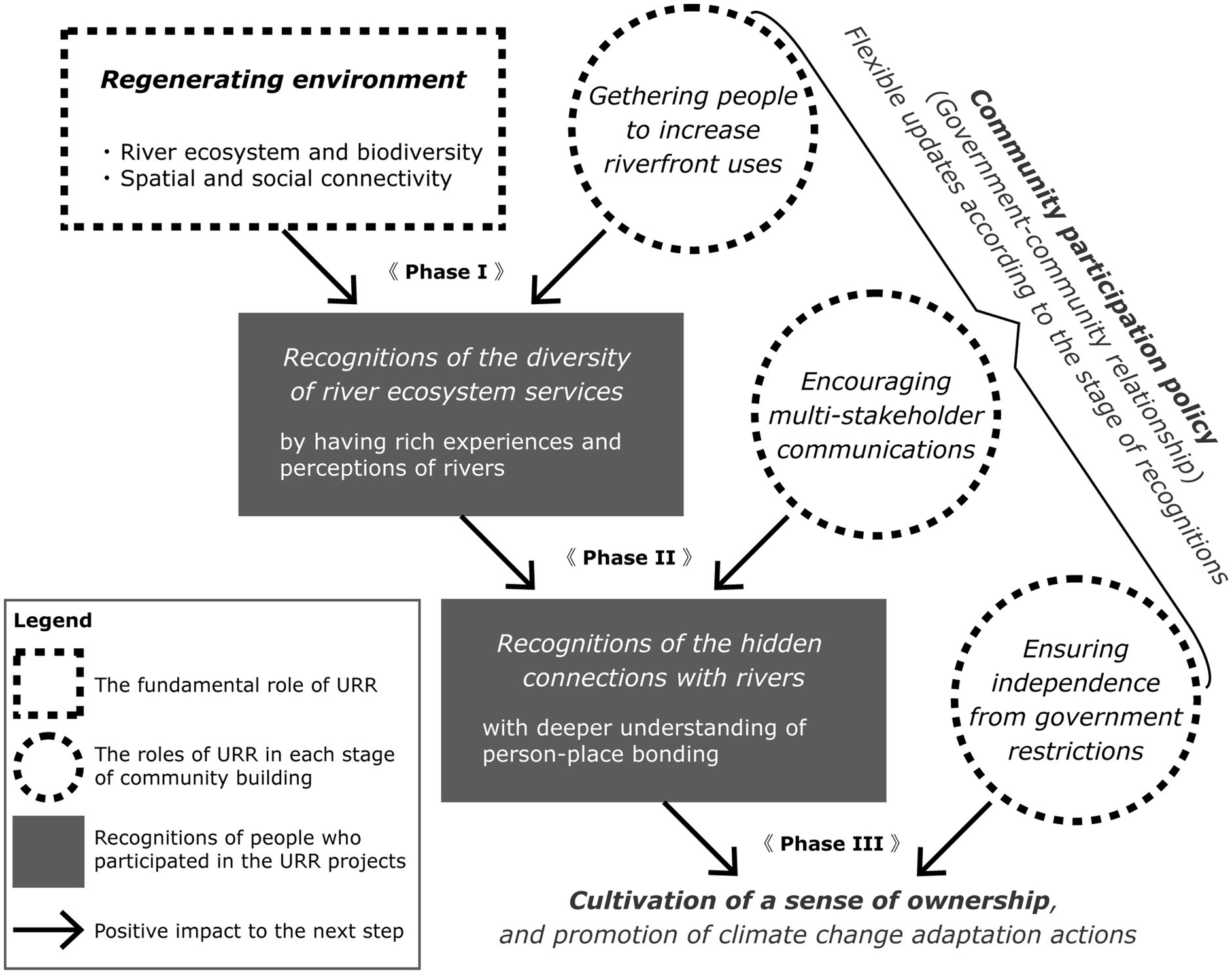
Figure 9. A conceptual methodology model for cultivating a sense of ownership through community-building processes of urban river restorations.
It should be noted that the meaning of the term “community” in community participation has evolved as the process has advanced. It has shifted from focusing on the potential users of the riverfront area, such as group members, to a more inclusive definition encompassing diverse backgrounds, including the general public. This indicates the necessity to dynamically redefine community in response to the stages of participants’ involvement understanding.
To apply the findings of this research to other cases, it is essential to consider the sociocultural differences of the target case. Specifically, the political and economic situation of Okazaki City in Japan has created a unique context characterized by the government-community relationship. Since 2000, there has been a growing movement for community involvement in Japan. Okazaki City has emerged as a leader in community participation in these cities. In 2006, the establishment of the NPO Rita catalyzed positive change, acting as a liaison between the government and local communities. This initiative has led to notable outcomes, particularly in community participation. This suggests that person-place bonding may have been a critical factor in fostering a sense of ownership in the case of a favorable government-community relationship. Many studies on community-engaged adaptations (Hagedoorn et al., 2019; Johnston et al., 2022) have focused on the relationship between governments and communities, indicating that the social aspect is often more significant, especially in developing countries.
5 Conclusion
The investigation into the expansion process of local activities in Okazaki City, Japan, revealed that urban river restoration processes have the potential value of cultivating a sense of ownership and contributing to climate change adaptation at the local level. The case study demonstrated that a sense of ownership was developed in stages. Urban river restoration enhances awareness of the multifaceted ecosystem services rivers provide, facilitating access to the dynamic processes of nature. Furthermore, the initiative has facilitated the involvement of participants from various backgrounds, thereby enabling the recognition of the previously unidentified connection between rivers and local communities.
Urban river restoration can drive adaptation to climate change. To improve this role, it is essential to revitalize the connection between urban society and rivers and also encourage local participation corresponding to the situation of government-community relationship. We cannot expect short-term results, as it takes time to foster community engagement. However, as the limitations of large-scale infrastructure development become apparent, the importance of sustained efforts to raise public awareness about climate change adaptation is undeniable. The findings of this study provide valuable insights for future community-engaged adaptation strategies integrated with urban river restoration.
There are four significant limitations to this research. First, the analysis was conducted only on members of a local citizen group. To verify the comprehensive contribution to community-engaged climate change adaptation, interviews with more people or a questionnaire survey should be conducted to analyze the general public’s sense. However, there are two challenges: a lack of research resources and the difficulty of long-term monitoring to capture the gradual changes in public awareness. The second limitation is that we attempted to show the awareness changes that occurred in the past by analyzing the text of local group publications. Ideally, it would have been better to demonstrate changes in awareness through long-term surveys. The third point is that we have not been able to quantitatively and rigorously evaluate a sense of ownership. In this study, we examined the consistency of the theoretical framework alongside the observed phenomena and inferred the cultivation of a sense of ownership. The final limitation is that we have left future work to follow-up surveys to verify the effects of climate change adaptation practically recognized.
Data availability statement
The datasets presented in this article are not readily available because permission to access them is required from the interviewees. Requests to access the datasets should be directed to the corresponding author, aXRzdW1pLnl1dGEuMTk1QG0ua3l1c2h1LXUuYWMuanA=.
Ethics statement
Ethical approval was not required for the study involving humans in accordance with the local legislation and institutional requirements. Written informed consent to participate in this study was not required from the participants or the participants’ legal guardians/next of kin in accordance with the national legislation and the institutional requirements.
Author contributions
YI: Conceptualization, Data curation, Investigation, Methodology, Writing – original draft. TC: Conceptualization, Methodology, Supervision, Writing – review & editing. SW: Data curation, Funding acquisition, Writing – review & editing.
Funding
The author(s) declare that financial support was received for the research and/or publication of this article. This work was supported by MEXT KAKENHI 21H05178, JSPS KAKENHI 21J22563 and 24K22556, and ESPEC Foundation for Global Environment Research and Technology (Charitable Trust).
Acknowledgments
The authors thank the volunteer members of the local group ONE RIVER for cooperating with the interview and providing the dataset. They also want to thank Mr. Noriyasu Sawada in Ozu City, Ehime Prefecture, Japan, who led me to the case of Okazaki City.
Conflict of interest
The authors declare that the research was conducted without any commercial or financial relationships that could be construed as a potential conflict of interest.
Generative AI statement
The authors declare that no Gen AI was used in the creation of this manuscript.
Publisher’s note
All claims expressed in this article are solely those of the authors and do not necessarily represent those of their affiliated organizations, or those of the publisher, the editors and the reviewers. Any product that may be evaluated in this article, or claim that may be made by its manufacturer, is not guaranteed or endorsed by the publisher.
References
Ardoin, N. M., Bowers, A. W., and Gaillard, E. (2020). Environmental education outcomes for conservation: a systematic review. Biol. Conserv. 241:108224. doi: 10.1016/j.biocon.2019.108224
Ayers, J., and Forsyth, T. (2009). Community-based adaptation to climate change. Environ. Sci. Policy Sustain. Dev. 51, 22–31. doi: 10.3200/ENV.51.4.22-31
Belanche, D., Casaló, L. V., and Rubio, M. Á. (2021). Local place identity: a comparison between residents of rural and urban communities. J. Rural. Stud. 82, 242–252. doi: 10.1016/j.jrurstud.2021.01.003
Bernhardt, E. S., and Palmer, M. A. (2007). Restoring streams in an urbanizing world. Freshw. Biol. 52, 738–751. doi: 10.1111/j.1365-2427.2006.01718.x
Chung, J.-h. (2023). Who defines Community in Community-Based Adaptation: different perceptions of community between government and citizens in Ethiopia. Clim. Dev. 15, 122–131. doi: 10.1080/17565529.2022.2061894
Clavin, C. T., Helgeson, J., Malecha, M., and Shrivastava, S. (2023). A call for a National Community Resilience Extension Partnership to bridge resilience research to communities. npj Urban Sustain. 3, 1–4. doi: 10.1038/s42949-023-00102-3
Gernow, L., Legarth, J. V., and Olafsson, A. S. (2024). Comparing place meanings of recreational visits to coastal and inland nature. J. Outdoor Recreat. Tour. 48:100811. doi: 10.1016/j.jort.2024.100811
Groulx, M. (2017). ‘Other People’s initiatives’: exploring mediation and appropriation of place as barriers to community-based climate change adaptation. Local Environ. 22, 1378–1393. doi: 10.1080/13549839.2017.1348343
Hagedoorn, L. C., Brander, L. M., van Beukering, P. J. H., Dijkstra, H. M., Franco, C., Hughes, L., et al. (2019). Community-based adaptation to climate change in Small Island developing states: an analysis of the role of social capital. Clim. Dev. 11, 723–734. doi: 10.1080/17565529.2018.1562869
Johnston, K. A., Taylor, M., and Ryan, B. (2022). Engaging communities to prepare for natural hazards: a conceptual model. Nat. Hazards 112, 2831–2851. doi: 10.1007/s11069-022-05290-2
Kelly, E., Lee, K., Shields, K. F., Cronk, R., Behnke, N., Klug, T., et al. (2017). The role of social capital and sense of ownership in rural community-managed water systems: qualitative evidence from Ghana, Kenya, and Zambia. J. Rural. Stud. 56, 156–166. doi: 10.1016/j.jrurstud.2017.08.021
Kondolf, G. M., and Pinto, P. J. (2017). The social connectivity of urban Rivers. Geomorphol. Connect. Geomorphol. Binghamton 277, 182–196. doi: 10.1016/j.geomorph.2016.09.028
Kondolf, G. M., and Yang, C.-N. (2008). “Planning River restoration projects: Social and cultural dimensions” in River Restoration: Managing the Uncertainty in Restoring Physical Habitat (Hoboken, NJ: John Wiley & Sons).
Lachapelle, P. (2008). A sense of ownership in community development: understanding the potential for participation in community planning efforts. Community Dev. 39, 52–59. doi: 10.1080/15575330809489730
Lay, L., Yves-François, H. P., and Rivière-Honegger, A. (2013). Perception of Braided River landscapes: implications for public participation and sustainable management. J. Environ. Manag. 119, 1–12. doi: 10.1016/j.jenvman.2013.01.006
Mathevet, R., Bousquet, F., and Raymond, C. M. (2018). The concept of stewardship in sustainability science and conservation biology. Biol. Conserv. 217, 363–370. doi: 10.1016/j.biocon.2017.10.015
McNamara, K. E., and Buggy, L. (2017). Community-based climate change adaptation: a review of academic literature. Local Environ. 22, 443–460. doi: 10.1080/13549839.2016.1216954
Mishra, R. R., and Saxena, S. (2024). “Chapter 1 – cities and Rivers: a symbiotic relationship” in Managing Urban Rivers. eds. V. R. Shinde, R. R. Mishra, U. Bhonde, and H. Vaidya (Amsterdam: Elsevier), 3–24.
Nakamura, S. (2018). Creation of awareness to solve a trend away from Rivers: a practice of river education in the Zenpukuji River, Tokyo. Policy Practice Stud. 4, 11–20. doi: 10.69287/ppseb.4.1_11
Nakamura, S., and Oki, T. (2018). Paradigm shifts on flood risk Management in Japan: detecting triggers of design flood revisions in the modern era. Water Resour. Res. 54, 5504–5515. doi: 10.1029/2017WR022509
Nickel, N., and Schnurr, L.. (2024). “Why community engagement is essential to climate adaptation and resilience.” Tamarack Institute, 2024. Available online at: https://www.tamarackcommunity.ca/articles/why-community-engagement-is-essential-to-climate-adaptation-and-resilience
Piggott-McKellar, A. E., McNamara, K. E., Nunn, P. D., and Watson, J. E. M. (2019). What are the barriers to successful community-based climate change adaptation? A review of Grey literature. Local Environ. 24, 374–390. doi: 10.1080/13549839.2019.1580688
Sabbion, P. (2017). “Urban River restoration” in Urban sustainability and river restoration (Hoboken, NJ: John Wiley & Sons, Ltd.), 76–92.
Simon, K., Diprose, G., and Thomas, A. C. (2020). Community-led initiatives for climate adaptation and mitigation. Kōtuitui 15, 93–105. doi: 10.1080/1177083X.2019.1652659
Takizawa, K. (2022). On local environmental stewardship and participatory water infrastructure management methods in urban waterfront revitalization. Doctoral thesis. Fukuoka: Kyushu University.
United Nations Development Programme. (2015). “Community based adaptation to climate change.” Available online at: https://www.undp.org/publications/community-based-adaptation-climate-change
Wamsler, C., Alkan-Olsson, J., Björn, H., Falck, H., Hanson, H., Oskarsson, T., et al. (2020). Beyond participation: when citizen engagement leads to undesirable outcomes for nature-based solutions and climate change adaptation. Clim. Chang. 158, 235–254. doi: 10.1007/s10584-019-02557-9
Wantzen, K. M., Ballouche, A., Longuet, I., Bao, I., Bocoum, H., Cissé, L., et al. (2016). River culture: an eco-social approach to mitigate the biological and cultural diversity crisis in Riverscapes. Ecohydrol. Hydrobiol. New Chall. Dimen. Ecohydrol. 16, 7–18. doi: 10.1016/j.ecohyd.2015.12.003
Wohl, E., Lane, S. N., and Wilcox, A. C. (2015). The science and practice of river restoration. Water Resour. Res. 51, 5974–5997. doi: 10.1002/2014WR016874
Keywords: urban river restoration, climate change adaptation, sense of ownership, community engagement, volunteer, perception, water resource management, nature-based solutions
Citation: Itsumi Y, Chibana T and Watanabe S (2025) Cultivating a sense of ownership over climate change adaptation through the expansion process of local community activities stimulated by urban river restoration in Okazaki City, Japan. Front. Water. 7:1537235. doi: 10.3389/frwa.2025.1537235
Edited by:
Brian McIntosh, Griffith University, AustraliaReviewed by:
Melissa Haeffner, Portland State University, United StatesGabriela Ioana-Toroimac, University of Bucharest, Romania
Copyright © 2025 Itsumi, Chibana and Watanabe. This is an open-access article distributed under the terms of the Creative Commons Attribution License (CC BY). The use, distribution or reproduction in other forums is permitted, provided the original author(s) and the copyright owner(s) are credited and that the original publication in this journal is cited, in accordance with accepted academic practice. No use, distribution or reproduction is permitted which does not comply with these terms.
*Correspondence: Yuta Itsumi, aXRzdW1pLnl1dGEuMTk1QG0ua3l1c2h1LXUuYWMuanA=
 Yuta Itsumi
Yuta Itsumi Takeyoshi Chibana2
Takeyoshi Chibana2 Satoshi Watanabe
Satoshi Watanabe

